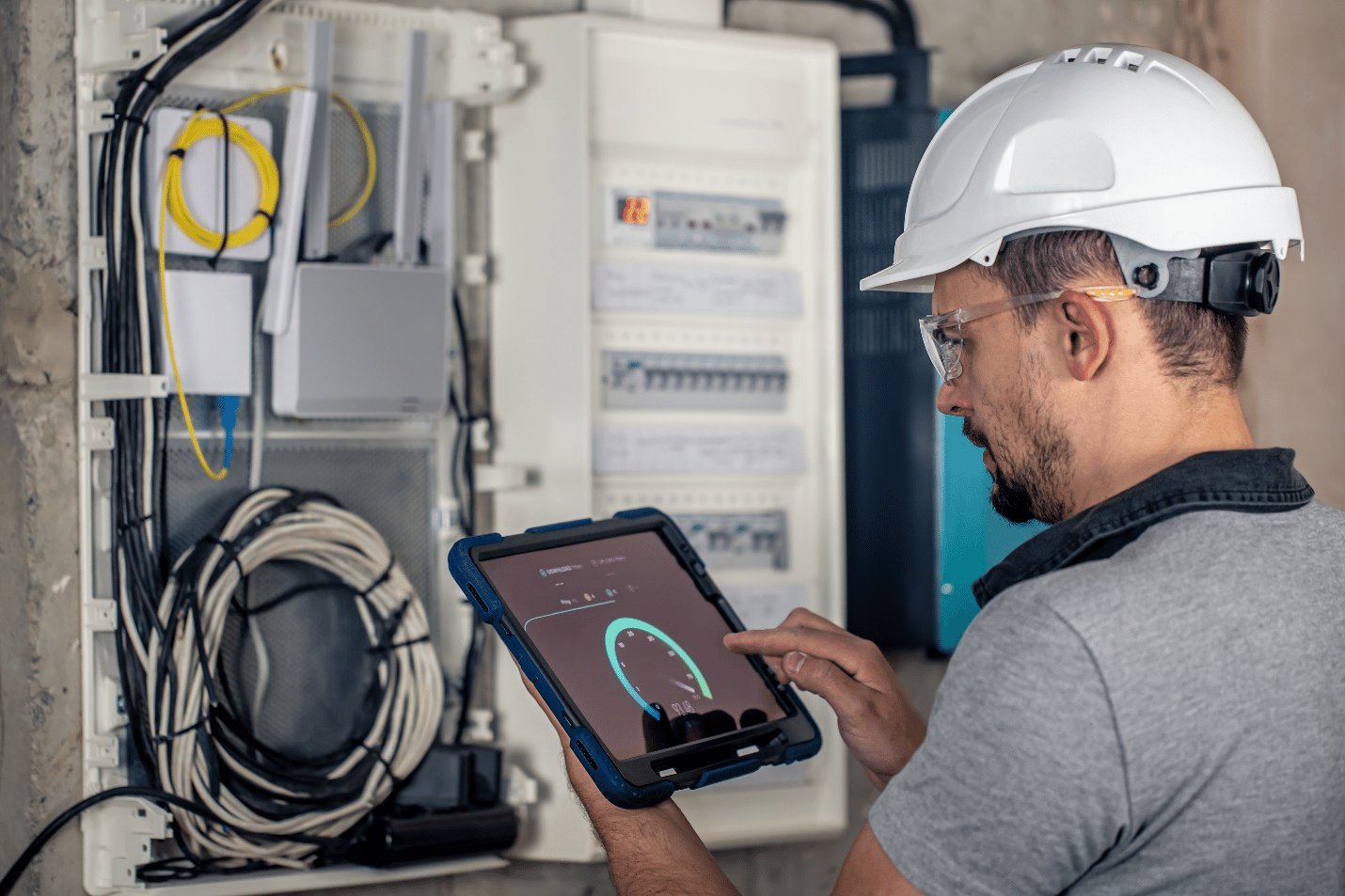Commercial electrical load calculations are important to determine the electricity needs of a building. As such, you can reduce energy consumption hence reducing electricity bills. This article provides a guide on how to calculate the electrical load of your building.
What Is an Electric Load?
An electric load is a device that consumes electrical energy, converting it into another form of energy, such as heat, light or motion. Some examples of electric loads include light bulbs, electric motors, and office equipment such as computers and printers.
Electric loads are an important factor in electrical engineering and power systems, as they determine the amount of power that must be generated and distributed to meet the electricity demand.
To determine how much power can support the energy needs of your building, you need commercial electrical load calculations. Tercero is a leading commercial electrical contractor who can help determine your needed power. If you need these services, feel free to contact us.
Types of Commercial Electric Loads
There are many types of commercial electric loads, which can vary depending on the specific needs of the commercial building. Some common types of commercial electric loads include:
- Lighting:Commercial buildings typically have many light fixtures, which consume significant electricity. It is one of the main electric loads in commercial buildings. The most common light fixtures are tubular fluorescent, compact fluorescent, T5 fluorescent, and LED lights, each with specific energy needs.
- HVAC (heating, ventilation, and air conditioning):Commercial buildings often have complex HVAC systems that use electricity to heat, cool, and ventilate the building. Ideally, they keep humidity between 40% and 60%, temperatures in the range of 72 degrees, and C02 levels below 1000PPM.
- Office equipment:Commercial buildings often have different electrical equipment, such as computers, telephone systems, and printers, that consume a significant amount of electricity. It is also a significant electric load in commercial buildings.
- Appliances:Commercial buildings also have kitchen appliances like refrigerators, ovens, dishwashers, washers and dryers. As you’d expect, they affect the electrical load of a commercial building. As such, it is crucial to include them in your calculations.
- Motors:There are a variety of motors in a commercial building, such as those used in elevators, escalators, and other machinery. Like appliances and lighting, they affect the final electric load of your building.
There are many different types of commercial electric loads, which can vary depending on the specific needs of the building. Understanding these electric loads and their characteristics is important for managing and maintaining the electrical system in a commercial building.
Tercero can help you identify the various electric loads in your building. We ensure to include every load in our calculation so we can accurately estimate how much energy you’ll need.
Calculating Commercial Electric Load

The formula for calculating the commercial electric load is relatively simple. It is based on the basic power formula, P = VI (where P is power, V is voltage, and I is current).
To calculate the commercial electric load, you would need to measure the current and voltage of each electric load in the commercial building and then use the formula P = VI to calculate the power consumption of each load.
Once you have the power consumption of each electric load, you can simply add them up to get the total commercial electric load.
For example, let’s say you have three electric loads in a commercial building with the following current and voltage measurements:
- Electric load 1: 5 amps at 120 volts
- Electric load 2: 2 amps at 240 volts
- Electric load 3: 1 amp at 120 volts
To calculate the commercial electric load, you would first use the formula P = VI to calculate the power consumption of each electric load. For electric load 1, the power consumption would be 5 amps * 120 volts = 600 watts.
For electric load 2, the power consumption would be 2 amps * 240 volts = 480 watts. And for electric load 3, the power consumption would be 1 amp * 120 volts = 120 watts.
Next, you would simply add up the power consumption of each electric load to get the total commercial electric load. In this case, the total commercial electric load would be 600 watts + 480 watts + 120 watts = 1,200 watts. This is the total amount of electricity that the commercial building consumes.
Benefits of Calculating a Commercial Building’s Electrical Load

There are several benefits to calculating the commercial electric load, including the following:
- It helps to ensure that the electrical system in the commercial building is capable of meeting the electricity demand. Knowingthe total electric load, you can ensure that the power supply and distribution systems are properly sized and configured to handle the load.
- You can identify areas where energy efficiency can be improved. Calculatingthe commercial electric load lets you see which devices and systems consume the most power.
As such, you can take steps to reduce their energy consumption. For example, you might replace old, inefficient appliances with newer, more efficient models or install energy-saving lighting systems.
- It can help to reduce the cost of electricity. Load calculations can help you identify ways to reduce the amount of power used, leadingto lower electricity bills.
For example, you might be able to negotiate a lower rate with your electricity provider if you can demonstrate that you have implemented energy-saving measures.
- It helps to prevent power outages and other electrical problems. It helps identify potential problems before they occur, such as overloaded circuits or inadequate power supply. It can help avoidpower outages and other electrical issues that disrupt your business operations.
Why Do You Need an Electrician To Calculate Commercial Electric Load?

While it is theoretically possible for someone who is not an electrician to calculate the commercial electric load, it is generally recommended that an electrician be hired to perform this task. There are several reasons for this, including the following:
- Electricians have the knowledge and expertise to accurately measure the current and voltage of each electric load in a commercial building. Itis an important part of calculating the commercial electric load, and it requires an electrician’s specialized knowledge and skills.
- Electricians have the tools and equipment to safely and accurately measure the current and voltage of each electric load. Itcan be a complex and potentially dangerous task, requiring specialized tools and equipment that an electrician has.
- Electricians can provide valuable insight and advice on reducingcommercial electric load. Once the electrician has calculated the commercial electric load, they can provide recommendations on how to reduce the electricity consumption of the building, such as by upgrading to more energy-efficient appliances or installing energy-saving lighting systems.
It is generally best to hire an electrician to calculate the commercial electric load, as they have the knowledge, expertise, and tools to safely and accurately perform this task.
Tools for Calculating the Commercial Electrical Load

Microsoft Excel
Microsoft Excel allows you to input all the necessary information, such as the type and number of electrical devices and appliances in a building. You’ll then use pre-determined formulas to calculate the total load. It is the most basic form of calculating the electric load of a commercial building. The software can help you calculate the following:
- The voltagedifference between phases.
- Load in each phase and the outgoing feeders.
- Starting, full load, continuous, and non-continuous load.
- Unbalanced load in the neutral wire.
Specialized Software
Another option is to use specialized electrical load calculation software. This type of software is specifically designed for calculating electrical loads and often includes features such as pre-populated electrical equipment databases and the ability to input and edit data easily.
Some of the key benefits of using specialized software include the following:
- Comprehensive:Many commercial electrical load calculation software comes with common electrical equipment databases. As such, it helps you ensure that all vital details are included in the calculations.
- Accuracy: This is arguably the chief benefit of using specialized software. As you’d expect, this software is specifically designed for this task. As such, it will provide more accurate results than using general-purpose software such as MS Excel.
- Efficiency: Generally, it is easier to use load calculation software than a general-purpose spreadsheet. It allows you to input and edit data quickly and easily. You can save time and effort using it.
- Customization:Some electrical load calculation software programs allow you to customize the calculations to take into account specific factors, such as the layout of the building or local building codes.
In short, specialized software for commercial electrical load calculations can help ensure that the calculations are comprehensive, efficient, and accurate. It can enable you to ensure the electrical system meets the power demands of your commercial building.
Conclusion
Calculating commercial electrical load is as easy as following the above formula. The best part? There is specialized software for this, and you can consult a professional electrician. If you need commercial electrical load calculations, Tercero is a perfect choice. Call us to book a consultation.

